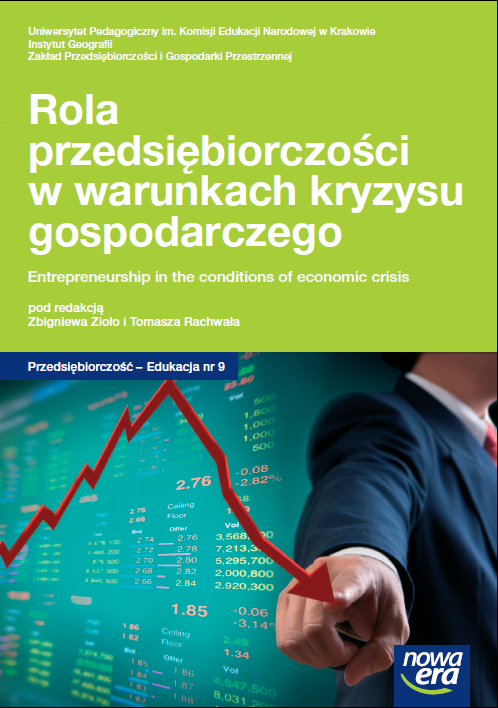Armaments in the period of an economic crisis
DOI:
https://doi.org/10.24917/20833296.9.15Keywords:
armament, national defense, crisis, weapon, military industryAbstract
Widespread discussions about crisis and its effects on military affairs are very popular among military scientists and journalists these days. Undertaken research focuses on question how crisis impacts military industry and defensiveness of states. It appears that financial problems didn’t change military expenditures so much as expected. Those expenditures in most countries are proportional to GDP like before crisis. However there are some regional exceptions. Middle East and North African countries are now ones, which have much increased military expenditures. There are also notable increases in China and Russia with other post-soviet republics. On the other hand, the slight decrease is noticed in Western Europe. Accordingly, there are different views reasoning this situation presented in the paper. Statistical data analysis show also some changes in main military equipment producers and buyers. All those are presented on attached maps of weapon’s international trade. Furthermore, at the end of paper there is local focus on discussed matter, concerning on polish military industry development dilemmas, challenges for polish defensiveness and military power of Republic of Poland.
References
Bauer, K. (2010). Kryzys finansowy a restrukturyzacja przedsiębiorstw w stanie upadłości, Prace Komisji Geografii Przemysłu Polskiego Towarzystwa Geograficznego, 15, Kraków–Warszawa, 209- 218.
Cooper, L.F. (2011). A world without great-power war, International Studies Review, 13 (4), 684-686.
Drembkowski, P. (2010). Od symetrii do „teorii chaosu” – nowy typ konfliktu zbrojnego XXI wieku, Studia Polityczne, 25, 147-162.
Eck, K. (2012). In data we trust? A comparison of UCDP, GED and ACLED conflict events datasets, Cooperation and Conflict, 47, 124-141.
Friedman, G. (2012). Poland’s Strategy, Stratfor Geopolitical Weekly, 4(8), 1-5.
Fukuyama, F. (1996). Koniec historii. Poznań: Zysk i Spółka.
Gałganek, A. (2011). Maszyny wojny. Technologia militarna w społecznej historii stosunków międzynarodowych, Przegląd Strategiczny, 2, 15-41.
Holtom, P., Bromley, M. (2012). Implementing the Arms Trade Treaty: Mapping Assistance to Strenghten Arms Transfer Control. SIPRI Insights to Peace and Security, 2, 1-20.
Holtom, P., Wezeman, S.T., Wezeman, P.D., Bromley, M., Kelly, N., Buchhold, C. (2012). International Arms Transfers. Solna: SIPRI.
IMF, Word Economic Outlook Database, http://www.imf.org/external/pubs/ft/weo/2011/02/weodata/ index.aspx Kile, S. N. (2012). World Nuclear Forces, SIPRI Yearbook 2012. Oxford: Oxford Univ. Press, 307-350.
Kiperska, J. (2000). Gra o Europę: bezpieczeństwo europejskie w polityce Stanów Zjednoczonych pod koniec XX wieku. Poznań: Instytut Zachodni.
Klin, T. (2011). Możliwości zastosowania zasad potęgometrii dla wybranych celów analizy geopolitycznej. Polityka i społeczeństwo, 8, 148-156.
Kołodziej, J. (2008). Europa w cieniu imperium. Euro-Facta, 1, 385-389.
Konopczak, M., Sieradzki, R., Wiercicki, M. (2010). Kryzys na światowych rynkach finansowych – wpływ na rynek finansowy w Polsce oraz implikacje dla sektora realnego. Bank i Kredyt, 41 (6), 45-70.
Królikowski, H. (2010). Offset – mity i rzeczywistość. Politeja - Pismo Wydzialu Studiow Miedzynarodowych i Politycznych Uniwersytetu Jagiellońskiego, 13, 511-529.
Milmo, D. (2012). BAE/EADS merger off as Angela Merkel refuses to endorse a deal. The Guardian, 10, 10. Pozyskano z: http://www.guardian.co.uk/business/2012/oct/10/bae-eads-merger-off-political- concerns Miłoszowska, D. (2009). Nowy porządek świata jako polityczna forma globalizacji, Geopolityka, 1(2), 41-47.
Münkler, H. (1994). Wojny naszych czasów. Kraków: WAM.
Nielsen, N. (2012). EU arms trade booming despite crisis. EU-Observer, 27(2), 2-4.
Official Journal of the European Union (2011). Thirteenth Annual Report According to Article 8(2) of Council Common Position 2008/944/CFSP Defining Common Rules Governing Control of Exports of Military Technology and Equipment. IV Notices from European Union Institutions, Bodies, Offices and Agencies, C 328, 1, aneks A 1.
Perlo-Freeman, S., Sköns, E. (2008). The private military services industry. SIPRI Insights on Peace and Security, 1, 1-20.
Perlo-Freeman, S., Solmirano, C., Kelly, N., Buchhold, C., Wilandh, H., Abdul-Shafi, W. (2012). Military Spending and Armament. Solna: SIPRI.
Pieroni, L. (2007). Military expenditure and economic growth. Defence and Peace Economics, 20(4), 327-339.
Rachwał, T. (2008). Problematyka badawcza funkcjonowania przedsiębiorstw przemysłowych. Prace Komisji Geografii Przemysłu Polskiego Towarzystwa Geograficznego, 11, Kraków-Warszawa, 53- 85.
Rachwał, T. (2011). Industrial restructuring in Poland and other European Union states in the era of economic globalization. Procedia. Social and Behavioral Sciences, 19, 1-10.
Rettman, A. (2012). EU figures show crisis-busting arms sales to Greece. EU-Observer, 7, 3, 2-3.
Silverman, H.I. (2011). Reuters: Principles of trust or propaganda. Journal Of Applied Business Research, 27 (6), 93-115.
SIPRI, Military Expenditure Database, http://www.sipri.org/research/armaments/milex/resultoutput/ milex_gdp SIPRI, The value of national arms exports, 2001–2010, in constant (2010) US$, www.sipri.org/research/ armaments/transfers/measuring/financial_values/constant.xls Skulski, P. (2011). Uwarunkowania marketingu na międzynarodowym rynku broni. Ekonomia, 1 (13), 192-206.
Sułek, M. (2001). Podstawy potęgonomii i potęgometrii. Kielce: WSEiA.
Sułek, M. (2008). Programowanie gospodarczo-obronne. Warszawa: Bellona.
Sułek, M. (2011). Potęga jednostek politycznych w oczach polskich grup eksperckich 2003-2011. Geopolityka, 5.
Pozyskano z: http://geopolityka.net/potega-jednostek-politycznych-w-oczach-polskich-grupeksperckich- w-latach-2003-2011/ Szatkowski, T. (2012). Kosztowna obronność. Forbes, nr z dn. 10 X.
Urbański, J., Sułek, M., Płaczek, J. (1992). Potencjał obronno-ekonomiczny i wydatki wojskowe. Warszawa: AON.
Wilczyński, P.L. (2011). Uwarunkowania geograficzne i zróżnicowanie regionalne konfliktów zbrojnych na świecie po II wojnie światowej, Łódź: WNG UŁ (rozprawa doktorska).
Downloads
Published
How to Cite
Issue
Section
License
Articles are published under the terms of the Creative Commons License (CC BY-ND 4.0; Attribution– NoDerivs).

